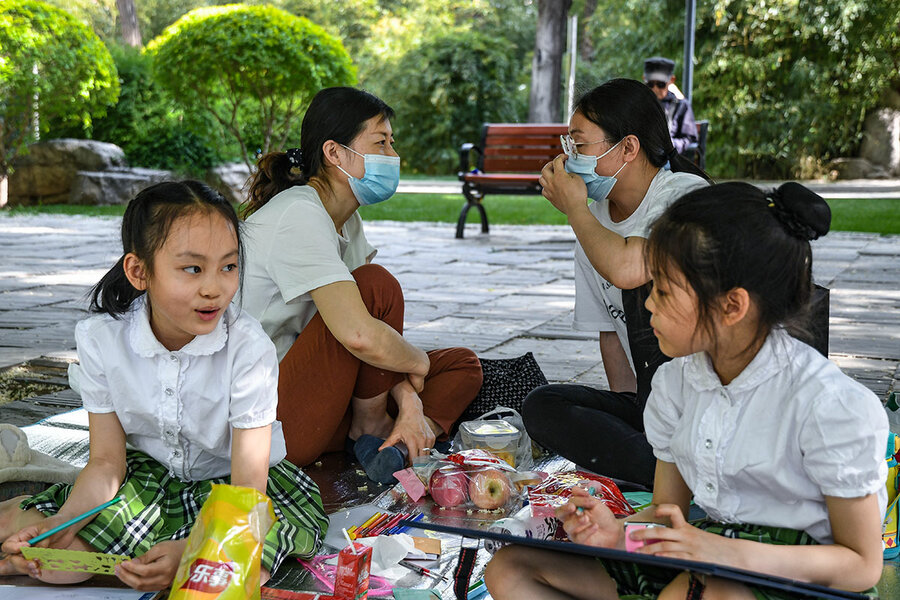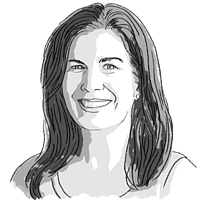Where were you April 21 at 4:17 p.m.? Beijing ramps up COVID tracking.
Loading...
| Beijing
Beijing residents had an unusually quiet May Day holiday this week, as the city ramped up restrictions on individual movement and activities in an effort to contain an ongoing COVID-19 outbreak.
The capital’s swift and strict containment drive has so far allowed it to avoid a full-scale lockdown like the one that immobilized Shanghai. Still, thousands of people are quarantined, and on Wednesday, the city shut down hundreds of bus and subway stations and urged its 21 million residents to work from home. As Beijing struggles to uphold Chinese leader Xi Jinping’s zero-COVID-19 policy, authorities are using a combination of persuasion, coercion, and appeals for self-sacrifice to bring about public compliance.
Why We Wrote This
China’s zero-COVID-19 regime combines elements that are at once Orwellian and paternalistic. People’s responses to them reveal a lot about Beijingers’ attitudes toward authority.
The official toolkit for controlling COVID-19 outbreaks now includes frequent mandatory testing, minute-by-minute location tracking, and dreaded pop-up windows in the mobile health app that block the green codes needed to move around the city. Beijing’s propaganda apparatus is also working overtime to highlight exemplary acts by citizens – and scold those skirting the rules.
For now, Beijingers are adjusting to the new constraints, but hoping for relief soon.
“The tests are free, and they are testing a lot,” says Ms. Zhu, who asked to withhold her first name. “Shanghai wasted a lot of time, but here the city reacted quickly and the measures are relatively strict, so this should be over very quickly.”
Workers built a giant, cloud-shaped display of 280,000 bursting red and yellow flowers in Tiananmen Square for this week’s May Day holiday, but stringent new controls to curb Beijing’s biggest COVID-19 outbreak meant relatively few people came to admire it.
Overnight, Beijing required visitors to show proof of a negative COVID-19 test taken within 48 hours to enter the square – as well as parks and other popular public places – leading many residents to stay home or be turned away. With restaurants, gyms, shopping malls, theaters, galleries, and other entertainment spots shuttered, Beijingers had limited options for their days off.
“We can’t go anywhere,” says Mr. Yu, a state-enterprise employee, on a walk with his girlfriend down a somewhat deserted main street. “We had plans for the holiday, but everything is closed,” he says, asking to withhold his first name.
Why We Wrote This
China’s zero-COVID-19 regime combines elements that are at once Orwellian and paternalistic. People’s responses to them reveal a lot about Beijingers’ attitudes toward authority.
Improvising, hundreds of vacationers gathered for picnics on Monday along the tree-lined Liangma River in northeast Beijing. But police cracked down on the gatherings the next day, warning outdoor diners they’d be punished.
Beijing’s swift and strict containment drive has so far allowed the city of 21 million people to stop short of a full-scale lockdown like the one that immobilized Shanghai. Still, thousands of people are quarantined and nearly 50 neighborhoods in the capital are now labeled high- or medium-risk and sealed off. At the same time, ever-tightening restrictions on movement and activities are seriously boxing in the rest of the population. Beijing on Wednesday extended school closures, told employees to work from home, shut down hundreds of bus and subway stations, and blocked people in risk groups from leaving Beijing.
Indeed, as Beijing and other big cities in China struggle to uphold Chinese leader Xi Jinping’s zero-COVID-19 policy, authorities are using a combination of persuasion, coercion, and appeals for self-sacrifice to bring about public compliance.
On Thursday, Mr. Xi underscored that China must stick with its aggressive controls, which have succeeded in keeping China’s overall case and fatality levels low by global standards. The Communist Party’s powerful Politburo Standing Committee stressed the need to “resolutely fight against all words and deeds that distort, doubt and deny our country’s anti-epidemic policies,” according to the official Xinhua News Agency.
Extreme contact tracing
The capital city’s official toolkit for controlling COVID-19 outbreaks now includes near-constant testing, labyrinthine contact tracing diagrams, minute-by-minute location tracking, and dreaded “health code” pop-up windows, which block the green codes people need to move around the city.
Such tools are the key to dividing the population based on COVID-19 risk: Those who test positive or are possibly exposed must go to hospitals and centralized quarantine facilities or be locked down at home. Those who continuously test negative and manage to steer clear of risky people and places can keep circulating.
The outbreak, which began April 22 and has surpassed 600 cases, now impacts 15 of Beijing’s 16 districts, according to the Beijing Center for Disease Control and Prevention.
Almost daily, Beijing publishes long, detailed lists of new COVID-19 risk locations. Officials ask citizens to self-report should their paths cross those of an infected person – at Shanxi Noodle House in Xiaogaoshe Village for two minutes between 4:15 and 4:17 p.m. on April 21, for instance.
“Friends … anyone who meets the time and space of the following itinerary … please take the initiative to report … and cooperate with centralized isolation,” reads one typical announcement.
At a daily press briefing, Beijing officials also list, by number, every new positive case in the city, with details of where the person lives, works, their relationships, and health status. They publish maze-like contact tracing flow charts, with bubbles for each case, highlighting transmission chains and links to risky areas of the city.
“I definitely avoid the high risk and medium risk areas,” says Yu Lei, a Beijing resident and college graduate, who says the outbreak has complicated her job search. “If everyone is determined and avoids each other, we can stop more outbreaks and control it really well.”
Others largely ignore such case tracking. “I don’t pay much attention to it,” says Daniel, an office worker, typing on his computer at a park bench. “If we want to go to an area and it’s locked down, we can’t go there,” he says, asking to withhold his last name.
All the testing, tracking, and quarantine requirements come together in Beijing’s “health treasure” app. The app registers a person’s identity card, cellphone number, test and vaccination details, and travel history with the Beijing Big Data Center, and turns green, yellow, or red based on the person’s health status. Expanded restrictions have triggered a flurry of calls to Beijing’s CDC hotline over health code problems and app glitches, including pop-up windows that won’t go away after testing.
Heroic Case 218
Beijing’s propaganda apparatus is working overtime to highlight exemplary acts by citizens and party members fighting COVID-19. Case 218, an interior decorator, got a call at work one morning from Beijing’s CDC, telling him he was a close contact. But instead of returning to his housing compound, he sat outside in his car for 11 hours until he was tested and taken away to quarantine – sparing his entire community from lockdown.
Case 218 “protected many strangers, so they were not disturbed by the spread of the virus,” said an article in the Beijing Evening News. In contrast, it said others “disregard local prevention … go to the card room to play mahjong every day without wearing a mask … organize weddings and funerals … and do everything possible to conceal and falsify the situation.”
Undercover reporters for state media also expose and scold bad behavior, such as a recent television news report that filmed unaware Beijingers panic-buying fruits and vegetables and jamming together in checkout lines.
Overall, Beijing’s approach has been to tighten controls gradually and move from voluntary to mandatory. Residents were first asked to mass test, then told that if they don’t, pop-ups will block their green health codes. This Wednesday, the city started requiring weekly testing for access to public facilities and transportation.
While some Beijingers complain testing is a hassle, most accept the need for it and appreciate the government footing the bill.
“The tests are free, and they are testing a lot to quickly clear the outbreak,” says Ms. Zhu, who is working from home while helping her second grade son with online studies.
Beijing has learned from problems exposed in Shanghai, she says, withholding her first name. “Shanghai wasted a lot of time, but here the city reacted quickly and the measures are relatively strict, so this should be over very quickly.”
Taking another lesson from Shanghai, where the separation of children and parents for quarantine caused outrage, Beijing agreed to allow a family member to accompany each quarantined child. “Rather than saying that children are being quarantined, it is better to say they are on a ‘trip,’” advises an official release from Beijing’s Fengtai District. Hundreds of children are now under quarantine in Beijing.
For now, Beijingers are adjusting to the new constraints – and tensions – but hoping for relief soon. “We need to let the girls relax a bit,” says Song Huidi, sitting under a tree on a blanket and chatting with her friend while their school-age daughters draw. “This shouldn’t last long.”










